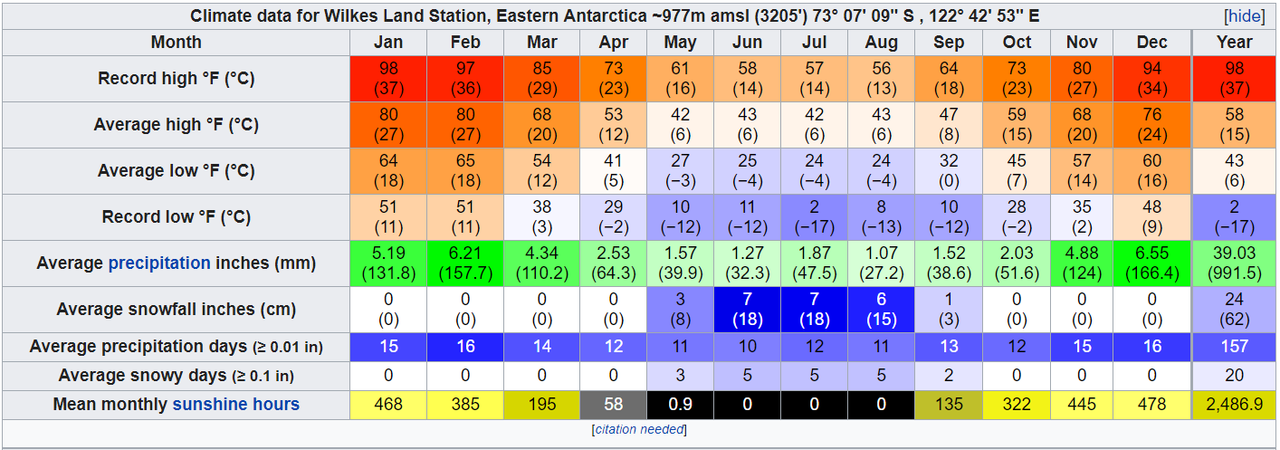Rate the K Climate: Wilkes Land Station, Eastern Antarctica
Jun 15, 2018 22:14:25 GMT -5
alex992, Hlidskjalf, and 3 more like this
Post by 🖕🏿Mörön🖕🏿 on Jun 15, 2018 22:14:25 GMT -5
And here we are in Cretaceous eastern Antarctica among the last of the dinosaurs and when mammals were just starting to get their foothold in the foodchain (although mammals or "mammals" aka mammalian-like reptiles, were around in the Triassic from what we know).
This is a rough estimation of the climate at present day 73S,122E in eastern Antarctica at roughly 977m amsl, based on some research I did. The earth was much warmer during the Cretaceous Period (shortened to K for the German name Kreide). Even at the south pole, summers were warm enough for dense forests comprised of large trees and plants (conifers, ferns, and probably ginkgo trees were common). There were most likely even cycad trees down at lower elevations.
The overall climate was somewhat similar to some highland areas of today's China and Japan, but obviously with a few differences as this is at a polar latitude which would affect seasonal changes. This is quite an inland location and at an elevation of 977m (which is roughly the mean elevation for that area without ice) produces a decent diurnal range in the drier winter season. Summer is much drier compared to coastal areas but still sufficiently wet to maintain the dense forest. Snowfall is sporadic and true cold waves are nonexistent, although the average coldest temperatures occur consistently during winter. Winter record lows are relatively mild and like snowfall, occur sporadically.
I don't think it would be sunnier than what I have here in the summer. If anything, my numbers are probably a bit too sunny given that some climates at 74N/S today have less sun. But then again, summer here is highly convective unlike today's polar locations. Based on sunshine data ratios from Resolute, Nunavut (74N) (May there averages 41% of possible sunshine -> 308/750 hours), I've extrapolated that to our climate here and produced numbers in the 60% possible range but that's probably at the upper limit. It's possible there could've been quite a few "Chongqings" in Antarctica at that time, regarding sunshine at least.
My rating is an A-. Just wish it was snowier and the winter darkness would suck. But on the bright side, those warm humid summers would be amazing with that amount of daylight.

This is a rough estimation of the climate at present day 73S,122E in eastern Antarctica at roughly 977m amsl, based on some research I did. The earth was much warmer during the Cretaceous Period (shortened to K for the German name Kreide). Even at the south pole, summers were warm enough for dense forests comprised of large trees and plants (conifers, ferns, and probably ginkgo trees were common). There were most likely even cycad trees down at lower elevations.
The overall climate was somewhat similar to some highland areas of today's China and Japan, but obviously with a few differences as this is at a polar latitude which would affect seasonal changes. This is quite an inland location and at an elevation of 977m (which is roughly the mean elevation for that area without ice) produces a decent diurnal range in the drier winter season. Summer is much drier compared to coastal areas but still sufficiently wet to maintain the dense forest. Snowfall is sporadic and true cold waves are nonexistent, although the average coldest temperatures occur consistently during winter. Winter record lows are relatively mild and like snowfall, occur sporadically.
I don't think it would be sunnier than what I have here in the summer. If anything, my numbers are probably a bit too sunny given that some climates at 74N/S today have less sun. But then again, summer here is highly convective unlike today's polar locations. Based on sunshine data ratios from Resolute, Nunavut (74N) (May there averages 41% of possible sunshine -> 308/750 hours), I've extrapolated that to our climate here and produced numbers in the 60% possible range but that's probably at the upper limit. It's possible there could've been quite a few "Chongqings" in Antarctica at that time, regarding sunshine at least.
My rating is an A-. Just wish it was snowier and the winter darkness would suck. But on the bright side, those warm humid summers would be amazing with that amount of daylight.





